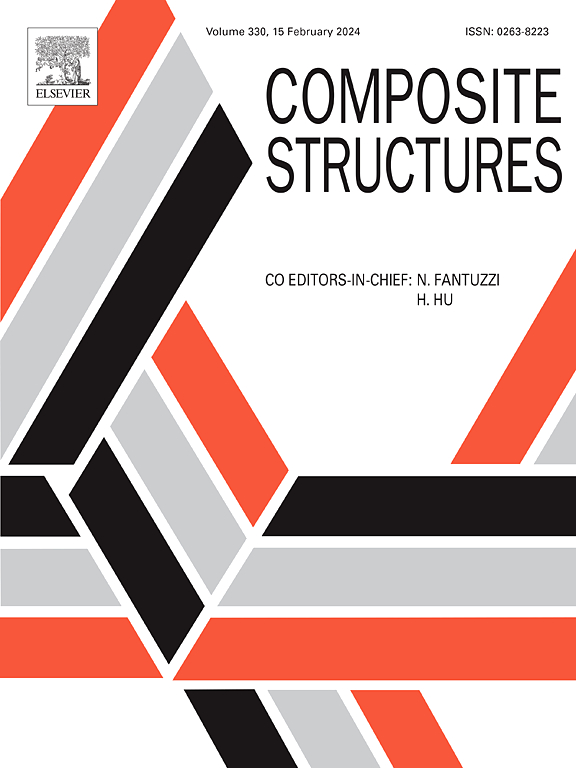The role of intra-laminar hybridization on the thermo-mechanical behaviour of fibre-hybrid composites using 3D RVEs
IF 6.3
2区 材料科学
Q1 MATERIALS SCIENCE, COMPOSITES
引用次数: 0
Abstract
The effect of intra-laminar hybridisation (i.e., two fibres within the matrix) on the effective coefficients of thermal expansion and thermomechanical behaviour of fibre-hybrid unidirectional composite laminae is investigated in this study. The research focuses on S-glass/epoxy and carbon/epoxy laminae hybridised with a secondary thermoplastic fibre (i.e., polypropylene, PET and PEEK). To conduct micro-mechanical analyses under transverse tensile and shear loading conditions (with and without thermally induced residual stress), three-dimensional representative volume elements (3D RVEs) are developed. The effects of using different microstructures, volume fractions, fibre diameters, and thermal cycles on interfacial and matrix microstress fields are investigated. The predicted homogenised elastic properties are validated against experimental data, while the predicted effective coefficients of thermal expansion of the RVEs models are validated against two well-established analytical models (i.e., Schapery and Mori-Tanaka). The results indicate that intra-laminar fibre hybridisation can alter the lamina’s effective coefficients of thermal expansion and micro-stress fields. Notably, the inclusion of polypropylene (PP) fibres as secondary fibres significantly increases interfacial stresses due to the substantial mismatch in the coefficient of thermal expansion between the PP fibres and the epoxy matrix. The extent of these alterations relies on variables such as fibres’ stiffness and coefficient of thermal expansion, thermal cooling-down cycle, and fibre volume fractions. This facet offers an opportunity for exploration as a method to regulate damage modes and, consequently, the processes of energy dissipation.
层内杂化对纤维杂化复合材料热力学行为的影响
本文研究了层内杂化(即两根纤维在基体内)对纤维-杂化单向复合材料层的热膨胀有效系数和热力学性能的影响。研究重点是s -玻璃/环氧树脂和碳/环氧树脂层与次级热塑性纤维(即聚丙烯,PET和PEEK)的杂化。为了进行横向拉伸和剪切加载条件下(有和没有热致残余应力)的微观力学分析,开发了三维代表性体积单元(3D RVEs)。研究了不同的微观结构、体积分数、纤维直径和热循环对界面和基体微应力场的影响。根据实验数据验证了预测的均匀弹性特性,而RVEs模型的预测热膨胀有效系数则根据两种成熟的分析模型(即Schapery和Mori-Tanaka)进行了验证。结果表明,纤维层内杂化可以改变层间热膨胀有效系数和微应力场。值得注意的是,聚丙烯(PP)纤维作为二次纤维的加入显著增加了界面应力,这是由于PP纤维和环氧树脂基体之间热膨胀系数的显著不匹配。这些变化的程度取决于纤维的刚度和热膨胀系数、热冷却周期和纤维体积分数等变量。这方面提供了一个探索的机会,作为一种方法来调节损伤模式,因此,能量耗散的过程。
本文章由计算机程序翻译,如有差异,请以英文原文为准。
求助全文
约1分钟内获得全文
求助全文
来源期刊

Composite Structures
工程技术-材料科学:复合
CiteScore
12.00
自引率
12.70%
发文量
1246
审稿时长
78 days
期刊介绍:
The past few decades have seen outstanding advances in the use of composite materials in structural applications. There can be little doubt that, within engineering circles, composites have revolutionised traditional design concepts and made possible an unparalleled range of new and exciting possibilities as viable materials for construction. Composite Structures, an International Journal, disseminates knowledge between users, manufacturers, designers and researchers involved in structures or structural components manufactured using composite materials.
The journal publishes papers which contribute to knowledge in the use of composite materials in engineering structures. Papers deal with design, research and development studies, experimental investigations, theoretical analysis and fabrication techniques relevant to the application of composites in load-bearing components for assemblies, ranging from individual components such as plates and shells to complete composite structures.
 求助内容:
求助内容: 应助结果提醒方式:
应助结果提醒方式:


